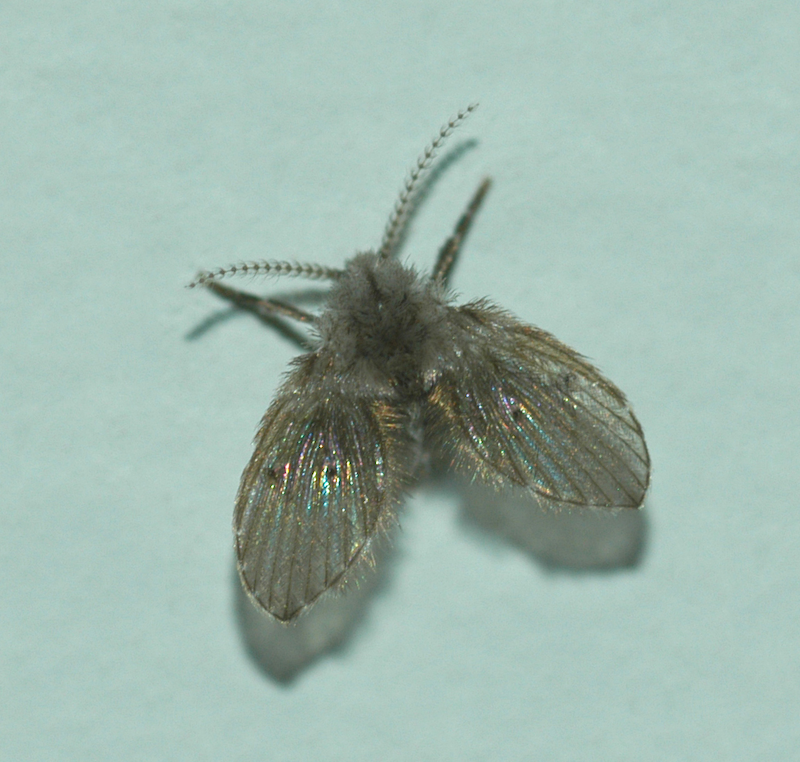Sewage Gnat, Vol. 7, No. 29
Clogmia albipunctata
Order: Diptera
Family: Psychodidae
This is the proverbial fly on the wall, at least in public restrooms. You have probably seen these many times over the years, sitting there while you were washing your hands. You may have even wondered just what you were seeing. Is it a moth, a fly, or some other kind of insect? Of course, restrooms aren’t the only places they occur. These small, furry flies have several common names, most of which refer to their unsanitary breeding sites: drain flies, filter flies, moth flies, and sewage gnats.
Adult sewage gnats are about 1/8 to 3/16 inches long and look like tiny moths, with their broad, hairy wings, held parallel to the surface on which they are resting. But they only have one pair of wings, which is a defining character of adult flies. Look closely at the wings and you will see the veins run parallel to one another, unlike most other flies. Those hairs on the wings are water-repellent, which helps keep the flies from drowning or becoming water-logged in the aquatic and semi-aquatic environments where they live.
The slender, legless larvae breed in moist or semi-aquatic settings with high organic matter. This can include municipal sewage plants, home septic tanks and pipes, sewage leaks, animal waste, sump pumps, storm drains, moist compost, bird baths, tree holes, AC drip pans, and similar situations. They are called drain flies because larvae thrive on the organic scum that accumulates on the inner walls of plumbing drains. Larvae breath through a tube at the rear of their bodies, and the entrance to this tube is surrounded by a wreath of water-repellent hairs. This lets larvae feed with their heads embedded in the organic slime on the inner walls of drainpipes, or in other aquatic or semi-aquatic situations and still be able to breath.
Control: Control of sewage gnats depends on either eliminating their breeding sites or excluding the adults. If adult flies are frequently seen in a bathroom, they are probably coming from drains in the sink/tub/shower, breaks in the wax seal around the toilet or larvae breeding in moisture and organic matter accumulating under cracked tiles in floors or showers. Finding and correcting the cause is the key to control.
To determine if flies are emerging from drains, place a piece of duct tape over the drain at night and check for adult flies the next day, or use a jar inverted over the drain. The best long-term control for sewage gnats breeding in drains is to use microbial drain cleaners to clean the inner walls of the pipes. Examples include: Drain Gel, Green Gobbler, DF 5000 and many others. These are usually gel-based products or products that foam when used so they cling to the insides of the pipes. Special wire brushes can be used to hasten cleaning for heavy infestations.
If large numbers of sewage gnats suddenly appear in an infrequently used guest room or other area of the house, check the drains of any sinks and toilets in the area. It may only be that the P-traps have dried out, allowing flies to enter from the sewage system. Breaks in the wax seal around a toilet can also be the cause of a sudden influx of sewage gnats, or other flies.
See pages 41-43 of Publication 2443, Control Household Insect Pests for more information.
Blake Layton, Extension Entomology Specialist, Mississippi State University Extension Service.
The information given here is for educational purposes only. Always read and follow current label directions. Specific commercial products are mentioned as examples only and reference to specific products or trade names is made with the understanding that no discrimination is intended to other products that may also be suitable and appropriately labeled.
Mississippi State University is an equal opportunity institution.
Bug’s Eye View is now on Facebook. Join the Bug's Eye View Facebook group here.


